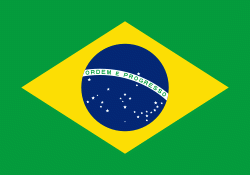Ouro Preto (Ouro Preto)
 |
 |
Ouro Preto is located in one of the main areas of the Brazilian Gold Rush.
Officially, 800 tons of gold were sent to Portugal in the eighteenth century, not to mention what was circulated in an illegal manner, nor what remained in the colony, such as gold used in the ornamentation of the churches. The municipality became the most populous city of Latin America, counting on about 40,000 people in 1730 and, decades after, 80,000. At that time, the population of New York was less than half of that number of inhabitants and the population of São Paulo did not surpass 8,000.
Ouro Preto was the capital of Minas Gerais from 1720 until 1897.
Other historical cities in Minas Gerais are São João del-Rei, Diamantina, Mariana, Tiradentes, Congonhas and Sabará.
Founded at the end of the 17th century, Ouro Preto (meaning Black Gold) was originally called Vila Rica, or "Rich Village", the focal point of the gold rush and Brazil's golden age in the 18th century under Portuguese rule. Between 1695 and 1696, a gold-bearing stream was discovered in Itacolomi, which would be renamed Gualacho do Sul. In 1711, several small settlements were united as a municipality called Villa Rica, which later came to be called Ouro Preto. This name was adopted on 20 May 1823, when the former Vila Rica was elevated from village to city. "Black Gold" comes from the gold covered with a layer of iron oxide that is found in the city.
The city centre contains well-preserved Portuguese colonial architecture, with few signs of modern urban development. New construction must keep with the city's historical aesthetic. 18th- and 19th-century churches decorated with gold and the sculptured works of Aleijadinho make Ouro Preto a tourist destination.
The tremendous wealth from gold mining in the 18th century created a city which attracted the intelligentsia of Europe. Philosophy and art flourished, and evidence of a baroque revival called the "Barroco Mineiro" is illustrated in architecture as well as by sculptors such as Aleijadinho, painters such as Manoel da Costa Ataíde, composers such as Lobo de Mesquita, and poets such as Tomás António Gonzaga. At that time, Vila Rica was the largest city in Brazil, with 100,000 inhabitants.
In 1789, Ouro Preto became the birthplace of the Inconfidência Mineira, a failed attempt to gain independence from Portugal. The leading figure, Joaquim José da Silva Xavier, known as Tiradentes, was hanged as a threat to any future revolutionaries.
In 1876, the Escola de Minas (Mines School) was created. This school established the technological foundation for several of the mineral discoveries in Brazil.
Map - Ouro Preto (Ouro Preto)
Map
Country - Brazil
Currency / Language
| ISO | Currency | Symbol | Significant figures |
|---|---|---|---|
| BRL | Brazilian real | R$ | 2 |
| ISO | Language |
|---|---|
| EN | English language |
| FR | French language |
| PT | Portuguese language |
| ES | Spanish language |


















